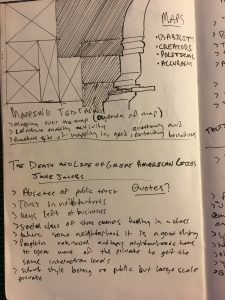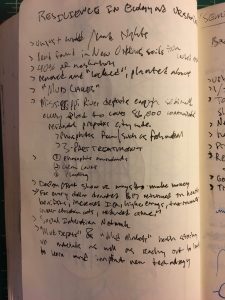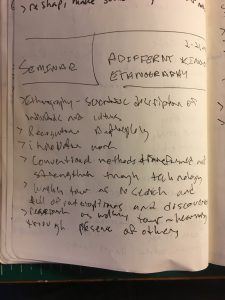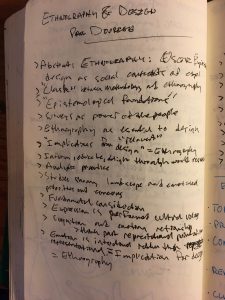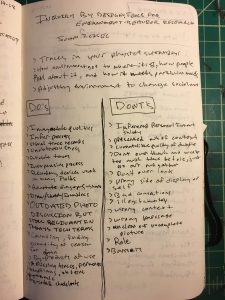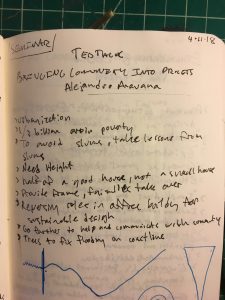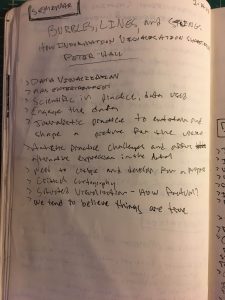Week 1:
Kimmelman, Michael. “In Protest, the Power of Place.” The New York Times. October 15, 2011. http://www.nytimes.com/2011/10/16/sunday-review/wall-street-protest-shows-power-of-place.html.
Massey, Doreen. “Space – time and the politics of Location,” Architecturally Speaking: Practices of Art, Architecture, and the Everyday.
McClelland, Mac. “How to Build a Perfect Refugee Camp.” The New York Times. February, 2014. https://www.nytimes.com/2014/02/16/magazine/how-to-build-a-perfect-refugee-camp.html.
Rawlence, Ben. “Author Profiles the ‘Traumatized People’ Living in the World’s Largest Refugee Camp.” NPR. Jan 4, 2016. https://www.npr.org/2016/01/04/461891627/author-profiles-the-traumatized-people-living-in-the-worlds-largest-refugee-camp.
Salloum, Jayce. “untitled part 4” Vimeo. August 7, 2013. https://vimeo.com/71876226.
“The podcast about Songlines.” http://mpegmedia.abc.net.au/rn/podcast/2016/07/aim_20160703.mp3.
Urbach, Henry. “Exhibition as Atmosphere.” Log, no. 20 (2010): 11-17. http://www.jstor.org/stable/41765361.
Vigeland, Tess. “When A Budget Motel Is ‘Home,’ There’s Little Room For Childhood.” NPR. Aug 16, 2015. https://www.npr.org/2015/08/16/432472821/when-a-budget-motel-is-home-theres-little-room-for-childhood.
Week 2:
Csikszentmihalyi, Mihaly. “Design and Order in Everyday Life.” In The Idea of Design: A Design Issues Reader, ed. Victor Margolin and Richard Buchanan, 118-126. Cambridge, MA: MIT Press, 1995.
Hall, Peter. “The Art of Mapping.” Presentation at TEDxAustin, Austin, Texas, February 18, 2011.
Hunt, Jamer. “Just Re-Do It: Tactical Formlessness and Everyday Consumption.” In Strangely Familiar: Design and Everyday Life, edited by Andrew Blauvelt, 56-71. Minneapolis: Walker Art Center, 2003.
Jacobs, Jane. “The Uses of Sidewalks: Contact.” In The Death and Life of Great American Cities, 54-73. New York: Random House, 1961.
Rios, Michael. Whose Public Space: International Case Studies in Urban Design and Development, Edited by Madanipour Ali. Oxford: Routledge, 2010.
Week 3:
Hall, Peter. “Bubbles, Lines and String: How Visualisation Shapes Society.” In The Graphic Design Reader. London: Bloomsbury Academic, 2011.
Zeisel, John. Inquiry by Design: Tools for Environment-Behavior Research. Monterey, Calif: Brooks/Cole Pub. Co, 1981.
Week 4:
Booth, Wayne, Gregory Colomb And Joseph Williams. “From Topics to Questions.” In The Craft of Research, 35-50. 3rd ed. Chicago: The University of Chicago Press, 2008.
Elliott, Denielle, and Dara Culhane. A Different Kind of Ethnography: Imaginative Practices and Creative Methodologies. North York, Ontario: University of Toronto Press, 2016.
Week 5:
My Brooklyn. Directed by Kelly Anderson. New York City, New York: New Day Films, 2013.
“My Brooklyn” a documentary film done by , is a journalistic pice on Fulton Street Market or Mall. The once bustling street of street venders, thrift stores, and cheap wholesale goods is now overrun with designer stores and expensive restaurants today. This film brings insight to the community that once was, and how gentrification has pushed out countless families and other residents to the outskirts of these areas for new businesses and buildings to bring a “higher quality” lifestyle to a great hub of transportation in Brooklyn. The film follows the trail of how this all happened; the proposals, town meetings, council decisions, and opposition, and how ultimately the rich got richer and the hard work and opposition of the poor public was not heard. The sale of the Fulton Street Mall was one of the largest losses to the public fight, and large developers rapidly changed the area bringing in new designer shops and expensive housing. The film covers “FUREE’s” activism throughout the proposal process, and the work of the Pratt Center and the general public, hoping to incorporate some of the old and help preserve the local character in new developments. A huge community, culture, tradition, and lifestyle was lost in the heart of Brooklyn, and through video can be shown as something that is not too unfamiliar or far off from where we are today.
Zukin, Sharon. “Union Square and the Paradox of Public Space.” In Naked City: The Death and Life of Authentic Urban Places, 125-158. Oxford: Oxford University Press, 2008.
Week 6:
Spradley, James. “Asking Descriptive Questions” In The Ethnographic Interview, 44-60. Fort Worth, Texas: Holt, Rinehart and Winston, 1979
Week 7:
Gregor, Alison. “Crown Heights, Brooklyn, Where Stoop Life Still Thrives.” The New York Times, The New York Times, 17 June 2015, www.nytimes.com/2015/06/21/realestate/crown-heights-brooklyn-where-stoop-life-still-thrives.html.
Week 8:
McPhee, John. “Frame of Reference.” The Writing Life. The New Yorker, March 9, 2015, https://www.newyorker.com/magazine/2015/03/09/frame-of-reference-john-mcphee.
In The New York Time’s, “Frames of Reference”, McPhee talks about vividness, and borrowed vividness. He explains how when writing you should not presume that the reader has the same interests and has seen the same content as you. You should not reference a particular character or individual when describing something as the reader could be lost in the comparison. For example McPhee states “You will never land smoothly on borrowed vividness. If you say someone looks like Tom Cruise—and you let it go at that—you are asking Tom Cruise to do your writing for you. Your description will fail when your reader doesn’t know who Tom Cruise is”. Going further McPhee explains borrowed vividness, in a similar situation where a write may write “He looks a bit like Gene Wilder, and has some of the same manic energy.” Gene Wilder? Search me. But nota bene: when Joel says “the same manic energy,” he is paying back much of the vividness he borrowed.” Here the example explains how explaining the comparison can help. McPhee discusses how common points of reference are fading as well as how we are all learning to write punch lines.
Week 10:
